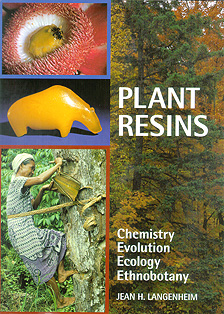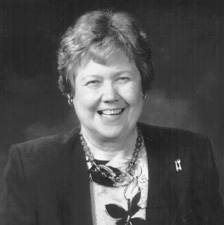|
May 26, 2003
UCSC botanist explores the fascinating world
of plant resins in a comprehensive new book
By Tim Stephens
From the Stone Age to the present day, people have found a wide range
of uses for plant resins and have been fascinated by amber, which is
fossilized resin. Plant resins--sticky plant secretions that harden
when exposed to air--have been used as medicines, fuels, varnishes,
adhesives, and perfume ingredients, to mention just a few examples.
|

|
|
Plant Resins: Chemistry, Evolution, Ecology, and Ethnobotany,
was published in May. Jean Langenheim, below, first became
interested in plant resins through her research on amber.
Photo by UCSC Photo Services.
|
 |
Jean Langenheim, professor emerita and research professor of ecology
and evolutionary biology, has been studying amber and resins for more
than 40 years. Her investigations have covered every aspect of the subject,
including the chemistry of resins, their geologic history, their roles
in the ecology of the plants that produce them, and their many uses
throughout human history.
Langenheim has now written a comprehensive book on plant resins that
reflects the depth and breadth of her knowledge as well as her enthusiasm
for these fascinating plant products. Plant Resins: Chemistry, Evolution,
Ecology, and Ethnobotany, published in May by Timber Press, is the
only up-to-date scientific reference book on the subject. It is richly
illustrated with maps, color and black-and-white photos, and exquisite
line drawings by UCSC alumnus Jesse Markman.
Langenheim first became interested in plant resins through her research
on amber. In the early 1960s, as a research fellow at Harvard University,
she conducted the first chemical analyses to determine the biological
sources of amber. Although people had assumed that most amber came from
the resins of pines and other conifers, Langenheim found that Mexican
amber came from a tropical flowering tree. This discovery led her to
conduct a comprehensive investigation of amber through geologic time,
identifying the different kinds of trees that could have produced amber
throughout the geologic record.
Langenheim's 1969 paper on amber in the journal Science became
a classic and established her as the world's leading authority on the
botanical sources of amber. She went on to conduct wide-ranging studies
of resin-producing trees, the chemical and anatomical mechanisms of
resin production, and the role of resins in defending plants from insects
and diseases.
"You might say I got stuck in the resin," Langenheim quipped.
She identified tropical trees in the genus Hymenaea, a legume belonging
to the same plant family as peas and beans, as the source of several
large deposits of amber in the New World. The greatest diversity of
Hymenaea species occurs in the Amazonian rain forest, where Langenheim
did extensive fieldwork.
"I actually started out as an ecologist studying high-mountain
vegetation, yet amber took me to the tropics," she said. "As
I made some breakthroughs in chemical studies of ambers and their botanical
sources, my training as an ecologist made me want to understand the
plants that produce these resins and why they may have started doing
it 300 million years ago."
The broad range of Langenheim's research on plant resins is one reason
Timber Press approached her in 1998 to write a general reference book
on the subject, the first since 1949. Langenheim's multidisciplinary
approach has produced an accessible and well-integrated book that should
appeal to a wide audience, including botanists, ecologists, ethnobotanists,
chemists, anthropologists, archaeologists, museum conservators, and
amber enthusiasts.
In the book, Langenheim suggests an improved definition of resins based
on their chemical properties, the secretory mechanisms that produce
them, and their ecological function. She also emphasizes the exciting
future of research on resins due to the continued development of new
technologies for chemical and biological studies.
The book has three main sections: the production of resins by plants;
the geologic history and ecology of resins; and the ethnobotany of resins.
Langenheim has done important work in all three areas.
"I've been fortunate in the way things developed. One thing led
to another and I just expanded across a broad array of topics,"
she said.
Serendipity often introduced her to just the right person at the right
time, Langenheim said. For example, when she needed to do research in
Amazonia, her guide to the region was the late Richard Evans Schultes
of Harvard, who had been exploring the Amazon basin since the 1940s
and became known as the father of modern ethnobotany.
Jesse Markman's line drawings for the book also came about through
serendipity, Langenheim said. She met Markman, a UCSC undergraduate
in biology at the time, when he asked her to supervise a seminar he
wanted to teach. Markman had just taken a course in science illustration,
and he showed Langenheim his work just when she was wondering who she
could get to do line drawings for the book. The editor at Timber Press
was so impressed that he submitted some of Markman's drawings to the
Hunt Institute for Botanical Documentation at Carnegie Mellon University
in Pittsburgh, where they will be kept in the institute's collection
and displayed at an international exhibition of botanical art and illustration
later this year.
"It's a great honor for an artist to have their work accepted
by the Hunt Institute," said Ann Caudle, coordinator of UCSC's
science illustration program. "They have one of the most respected
collections of botanical illustrations in the world, and they are very
selective."
Langenheim joined the UCSC faculty in 1966 at the invitation of the
late Kenneth Thimann, an eminent plant physiologist and one of UCSC's
founding faculty. She and Thimann cotaught a course on "Plants
and Human Affairs" and coauthored a book, Botany: Plant Biology
and Its Relation to Human Affairs.
Langenheim has served as the president of the Association for Tropical
Biology, the Ecological Society of America, the International Society
of Chemical Ecology, and the Society for Economic Botany. She also represented
UC on the board of directors and was academic vice president of the
Organization for Tropical Studies. She has traveled throughout the world
in the course of her research, but did not neglect her own backyard,
studying resin production in redwoods and other Pacific Coast plants
in addition to her work in the tropics.
Although technically retired for the past 10 years, Langenheim has
remained very active at UCSC and still has graduate students doing research
under her supervision. Frequently invited to speak before scientific
gatherings, she gave St. Louis University's annual John Dwyer Lecture
in Biology at the Missouri Botanical Garden in April. Her talk was entitled,
"What's So Interesting about Plant Resins?"
Return to Front Page
|